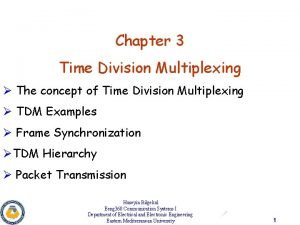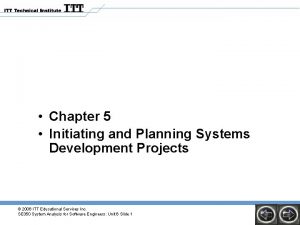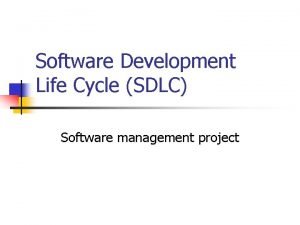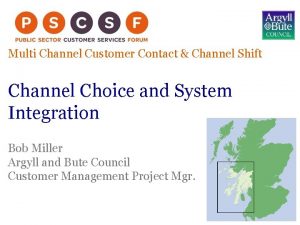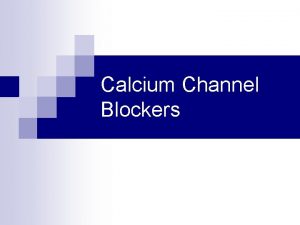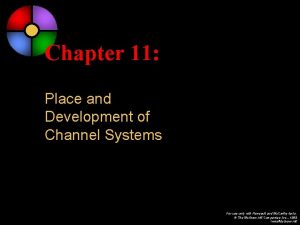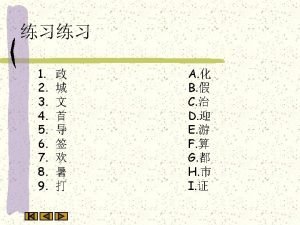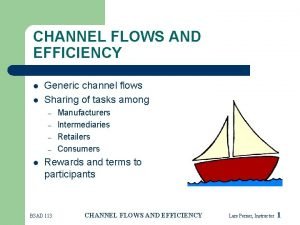Chapter 10 Place and Development of Channel Systems






















- Slides: 22

Chapter 10 Place and Development of Channel Systems Copyright © 2014 by The Mc. Graw-Hill Companies, Inc. All rights reserved

10 -2 At the end of this presentation, you should be able to: 1. 2. 3. 4. 5. Understand what product classes suggest about Place objectives. Understand why some firms use direct channel systems while others work with intermediaries and indirect systems. Understand how and why marketing specialists develop to make channel systems more effective. Understand how to develop cooperative relationships and avoid conflict in channel systems. Know how channel members in vertical marketing systems shift and share functions to meet customer needs.

10 -3 At the end of this presentation, you should be able to: Understand the differences between intensive, selective, and exclusive distribution. 7. Know how multichannel distribution and reverse channels operate. 8. Know the main approaches firms use to reach customers in international markets. 9. Understand important new terms. 6.

10 -4 Marketing Strategy Planning Process

10 -5 Marketing Strategy Planning Decisions for Place (Exhibit 10 -1) CH 10: Place and Development of Channel Systems Place objectives Direct vs. indirect CH 11: Distribution Customer Service & Logistics Channel specialists CH 12: Retailers, Wholesalers & Their Strategy Planning Channel relationships Market exposure

10 -6 Place Decisions Are Guided by “Ideal” Place Objectives Product Classes Suggest Place Objectives Key Issues Place Decisions Have Long-run Effects Place System Is Not Automatic

10 -7 Channel System May Be Direct or Indirect Greater Control Lower Cost Internet Makes Direct Distribution Easier Some Reasons For Choosing Direct Channels Direct Contact with Customers Suitable Intermediaries Not Available

10 -8 Direct Channels Are Common with Business Customers and Services

10 -9 When Indirect Channels Are Best

10 -10 Channel Specialists May Reduce Discrepancies and Separations

10 -11 A Discrepancy of Assortment Skiing? Skis, Poles Goggles Sporting Goods Retailer Wax

10 -12 Channel Specialists Adjust Discrepancies with Regrouping Activities Accumulating Bulk-Breaking Assorting Sorting

10 -13 Interactive Exercise: Channel Efficiency

10 -14 Channel Relationship Must Be Managed Choosing the Type of Relationship Key Issues In Channel Management Whole-Channel Product. Market Commitment Conflict Handling Role of Channel Captain

10 -15 Producers or Intermediaries May Be Channel Captains (Exhibit 10 -2) A. How strategy decisions are handled B. How strategy decisions are handled in a retailer-led channel in a producer-led channel Producer’s Intermediary’s Producer’s Retailer’s part of the job Product Place Product Customers Place Customers Price Promotion

10 -16 Vertical Marketing Systems Focus on Final Customers (Exhibit 10 -3) Type of channel Characteristics Vertical marketing systems Traditional Administered Contractual Corporate Little or none Some to good Fairly good to good Complete Control maintained by None Economic power and leadership Contracts One company ownership Examples Typical “inde -pendents” General Electric Amount of cooperation Mc. Donald’s Florsheim

10 -17 Interactive Exercise: Ideal Market Exposure

10 -18 Limiting Market Exposure Producer Vertical Arrangements May Be Legal Wholesaler Retailer 1 Retailer 2 Retailer 3 Horizontal Arrangements Are Illegal

10 -19 Channel Systems Can Be Complex (Exhibit 10 -4)

10 -20 Entering International Markets (Exhibit 10 -5) Exporting Licensing Management Contracting Joint Venture Direct Investment Generally increasing investment, risk, and control of marketing

10 -21 Key Terms 1. 2. 3. 4. 5. 6. 7. 8. 9. place channel of distribution direct marketing discrepancy of quantity discrepancy of assortment regrouping activities accumulating bulk-breaking sorting 10. 11. 12. 13. 14. 15. 16. 17. assorting traditional channel systems channel captain vertical marketing systems corporate channel systems vertical integration administered channel systems contractual channel systems

10 -22 Key Terms 18. 19. 20. 21. 22. 23. 24. 25. ideal market exposure intensive distribution selective distribution exclusive distribution multichannel distribution reverse channels exporting licensing management contracting 27. joint venture 28. direct investment 26.
 Regrouping activities marketing
Regrouping activities marketing Single channel marketing
Single channel marketing Signal space analysis in digital communication
Signal space analysis in digital communication Jfet self bias configuration
Jfet self bias configuration Place place value and period
Place place value and period Marketing distribution channel
Marketing distribution channel A disturbance that transfers energy
A disturbance that transfers energy Disturbance that transfers energy from place to place
Disturbance that transfers energy from place to place Tdm block diagram
Tdm block diagram Decision support systems and intelligent systems
Decision support systems and intelligent systems Development takes place gradually
Development takes place gradually Initiating and planning systems development projects
Initiating and planning systems development projects Potential development projects can be identified by
Potential development projects can be identified by Initiating and planning systems development projects
Initiating and planning systems development projects Chapter 24 the immune and lymphatic systems and cancer
Chapter 24 the immune and lymphatic systems and cancer What empties into the left subclavian vein
What empties into the left subclavian vein Are criteria for evaluating performance of channel members.
Are criteria for evaluating performance of channel members. Chapter 7 selecting the channel members
Chapter 7 selecting the channel members Engineering elegant systems: theory of systems engineering
Engineering elegant systems: theory of systems engineering Embedded systems vs cyber physical systems
Embedded systems vs cyber physical systems Elegant systems
Elegant systems Diversity and human needs and development
Diversity and human needs and development Software
Software








